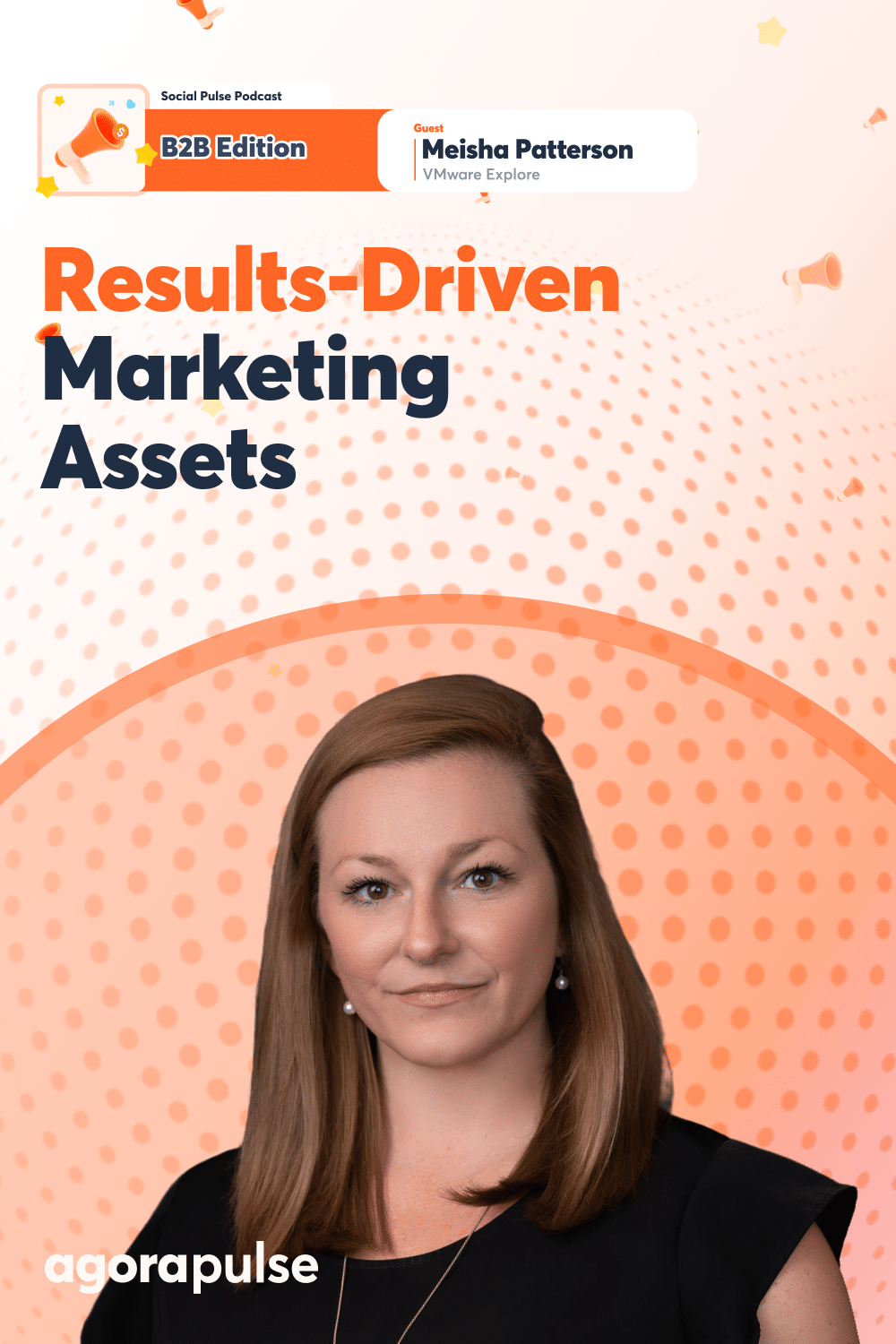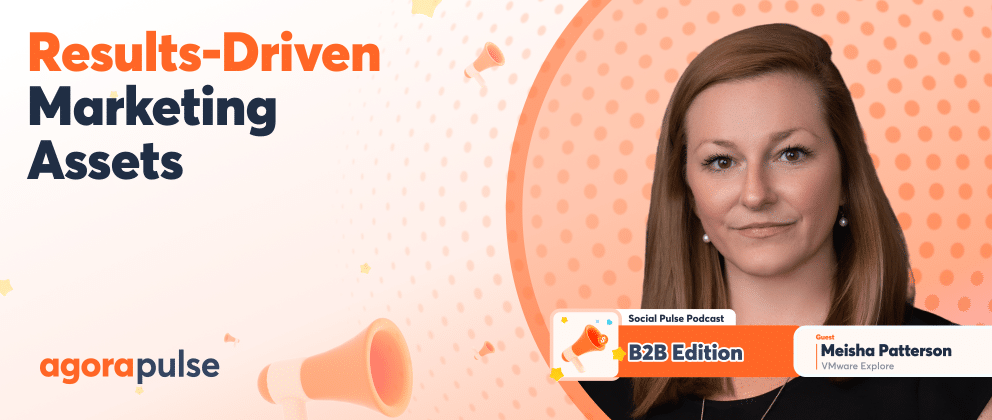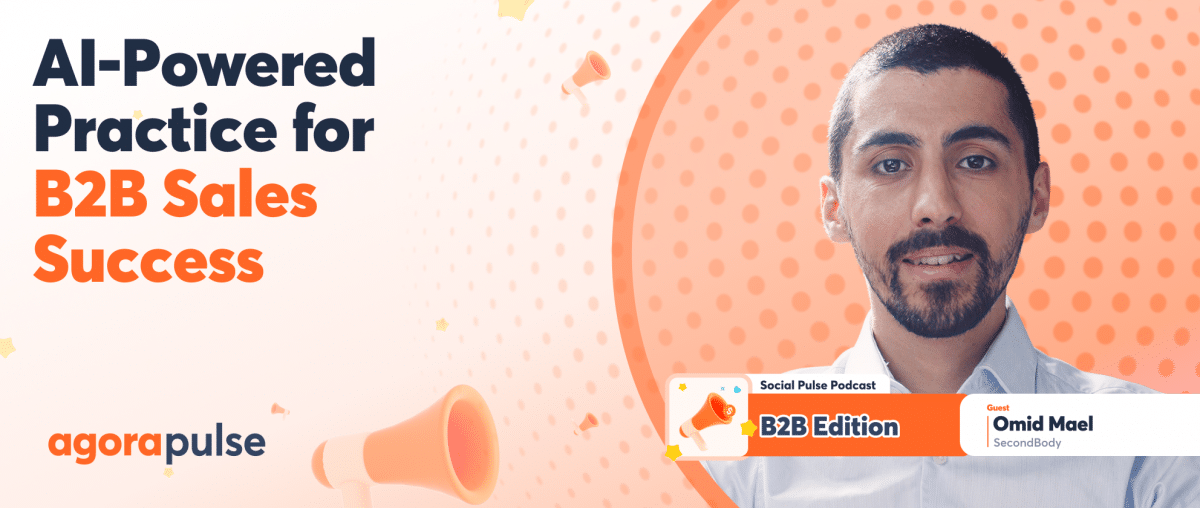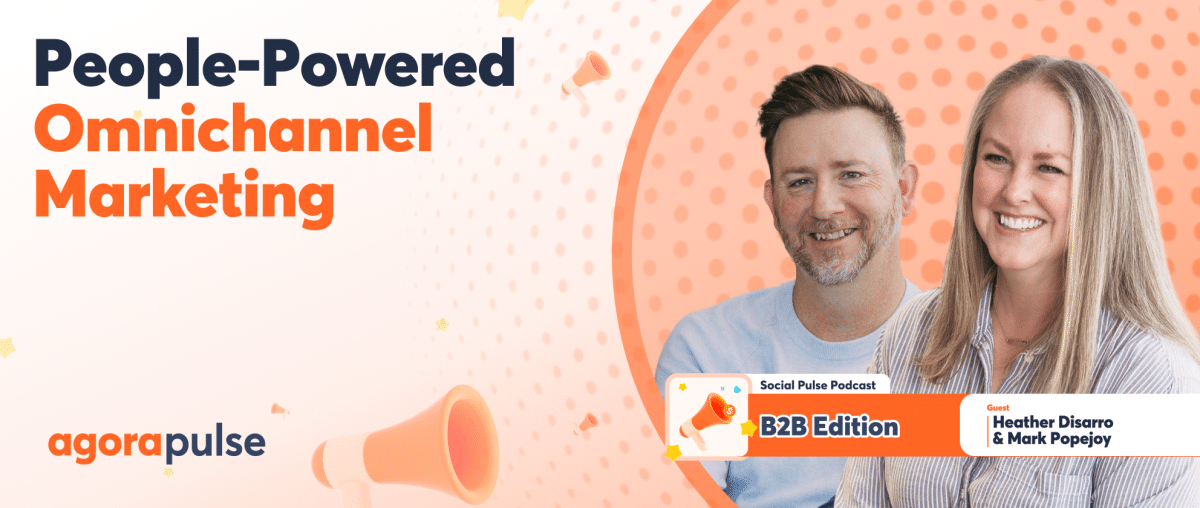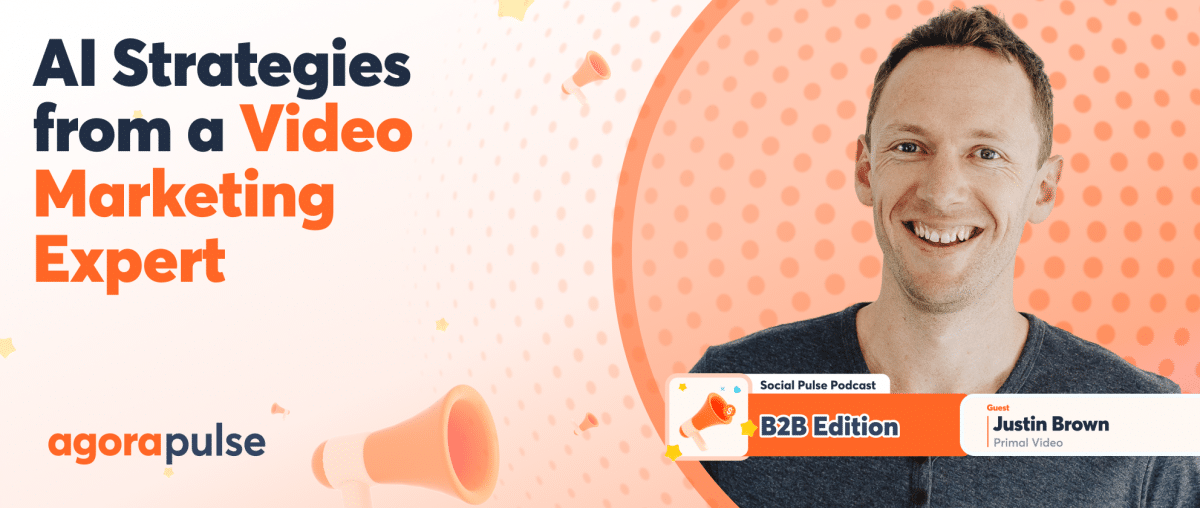Ever looked at your marketing assets and thought, “These look amazing, but are they actually driving results?” It’s a challenge that keeps many B2B marketers up at night. Your creative assets might be visually stunning, perfectly on brand, and beautiful, but are they converting? Are they truly connecting with your audience and moving the needle on your business objectives?
If you’re struggling with this balance between artistic excellence and business impact, you’re not alone.
Many marketing teams find themselves trapped in this cycle, creating visually appealing content that fails to drive meaningful engagement or conversions. Meisha Patterson, a dynamic digital marketing expert with a decade of experience, discusses all that in this episode of Social Pulse Podcast: B2B Edition, powered by Agorapulse, with our Chief Storyteller Mike Allton.
Meisha currently orchestrates the digital presence of VMware Explore as a self-proclaimed marketing enthusiast. She recently led a transformative creative refresh that turned beautiful, but abstract marketing assets into powerful conversion drivers.
[Listen to the full episode below, or get the highlights of the Social Pulse: Agency Edition, powered by Agorapulse. Try it for free today.]
Identifying Marketing Assets
How do you go identify marketing assets that just aren’t working?
Meisha Patterson: It’s a struggle. I think a lot of marketers have—and I would say, keep in mind just because you think something is beautiful. You think something looks great. Doesn’t naturally mean that that will translate into a high-performing marketing asset, or maybe it doesn’t resonate with your audience. So I’ve certainly been in a situation where I’m very close to a project and I think something looks great, but it doesn’t hit. (Just know that that’s normal. That’s okay.) But what can you do about it?
The first thing you want to do is consider your audience and make sure that your marketing assets are aligned with your audience.
This is something that I think happens more often than folks realize: You work so hard to create these beautiful marketing assets, and then you throw your campaign out, and there might be some misalignment [with] your audience, the messaging, and creativity.
Doing an audit to ensure that the message and the creative that you have in the market is aligned to the audience you’re trying to reach, but once you’re sure you do have that alignment there, I like to say, let the data tell the story here.
Engagement can be a particularly effective leading indicator that can tell you, “Are these ads resonating? Do people care about what we have to say? Are people clicking if that’s what you want them to do? Are people commenting? Are they sharing? Are they watching, like taking the time to stop their scroll and watch your video content if you’re running video ads?”
Those can be some effective early indicators that let you know, yes, what we have out in the market is resonating with our audience. If you’re seeing, based on your own historical data, if you have access to industry data your performance is not meeting those standards, or if it’s falling or lagging over time. That’s when I think you want to take a pause and say, “Okay, digging into why isn’t this as effective,” and maybe doing some research or getting some feedback from other folks or just starting from scratch. Going back to the drawing board and saying these ads didn’t hit, they didn’t land, we need to figure out why and take a new approach.
Of course, Mike, as you know, in the B2B, there’s a lot of nuance. My lens today is from B2B enterprise event marketing. So there are probably a lot of folks who might work in a product-led organization or a sales-led organization, your campaigns, and what you’re putting out into market might have different goals.
There’s a lot of nuance here, but I think engagement is your leading indicator and can make your spidey senses say, “Hey, this is not hitting, we need to take a second look at these.”
How do we know what’s working and what’s not and what you might need to change?
Meisha Patterson: This is where testing can be your best friend. So whether you’re using a lot of platforms now have native A/B testing tools built in. So this is where you can get down to the nitty-gritty and optimize your campaign. Maybe it’s not working, but you want to figure out why [and] do some testing.
Always test one thing at a time, multivariate testing can get a little bit more complex and tricky. I like to start just testing one thing at a time.
Are we going to test our copy and change our copy? That’s your test.
Are we going to test our call to action or what we want people to do? That’s a test.
Do we want to test different creatives with the same messaging and the same call to action? I think testing is absolutely the best route where you can start to go in and say, “Okay, we want to figure out maybe why this isn’t working or if it’s working okay, but we want to see if we can do even better.”
That’s where you want to start with your testing.
Mike Allton: To your point, if you’re doing paid ads, particularly on platforms like Meta, it has that capability built in. If you’re doing email marketing, you can split test subject lines, even parts of the body of the email. Of course, if you’re doing social media, organic social media testing is a little bit more challenging. You can schedule the same kinds of posts days and weeks apart and see how those resonate differently with different audiences—even knowing a lot of it’s different because different audiences see those at each time—but it’s the best we can do.
With social media, let’s assume for the moment that we’ve done some of this stuff. We’ve looked at our marketing assets, some posts or campaigns that are getting less than ideal engagement, and some determinations about what needs to change. And maybe it’s drastic. Maybe we need to completely blow away the kinds of graphics or videos that we were creating and build in a new strategy.
Maintaining Brand Consistency
How do we maintain brand consistency when we make a significant change?
Meisha Patterson: Determining the level of change you want to see is important.
I think you can probably think of a few companies where—Jaguar is a very relevant example where they had a brand refresh or not even a refresh, but a total rebrand and it’s everybody’s talking about it. Right?
Identifying the level of change you want and the impact, I think, is important.
Having a 180 of your brand and creative strategy is a big change. People are going to notice people are going to talk about it, whether it’s good or bad. It’s still up for debate for Jaguar, but people are talking about it.
I think you want to define that scale of change. For an ad campaign, do we want it to feel very different or outside of the box relative to our existing brand? Or do we want it to just be a fresh take on that?
Identifying where on the scale you’re feeling ultimately comes with brand team and design team alignment.
This can’t necessarily be something that the marketing team should or can fully own. I think you need that brand and design alignment.
For our team, when we did this—I think context is also important for folks—our company recently went through an acquisition. In prior event cycles, we had an internal team that would run our paid ad program on our behalf. We partnered with them. We gave them the information they needed, but they basically executed it from there. And it was so great. We had those internal resources, but after the acquisition, our team had the opportunity to retake the paid ads program and define what we wanted the future of this program to be.
In prior event cycles, we had rinsed and repeated what we were doing. We had our overall event brand. They had some marketing assets that were tied to event milestones and offers. And they built campaigns based on that using repurposed existing assets. And it was a little bit of a rinse and repeat every year where we were running paid ads.
It was almost a little bit of a checkbox marketing exercise where we’re kind of like, okay, paid programs, they’re out there. We can see conversions coming in. We think it’s fine. And when our team took this program over, there was just this natural appetite for change. We didn’t necessarily have the full historical picture just because folks had left, marketing assets had shifted to different places.
So we didn’t have a ton of historical context to build off, which worked out in our favor because there was this natural appetite for change. We had an opportunity to do something different and for our team to own it. And we wanted to make that change. (Also, you want to define why is there this appetite for change, what are we hoping to accomplish, and how big of a shift we want folks to pick up on.)
I find that for maintaining that consistency and initiating these conversations with your brand teams or with your design teams, it’s helpful to come up with a vision or with some type of idea or inspiration and to be as specific as possible.
It’s not helpful to come to your team and say, “Hey, team, we’re looking for a refresh.”
Our team did a lot of deep research and analysis, and we looked at other events within our industry, within our space, but also like completely different events, like consumer events, not B2B related. We looked at some that were B2B, but in different industries and verticals, pulled together a ton of examples, dissected what we liked, and what we didn’t like, and then worked directly with our brand and design partners to kind of help shape this new direction. That alignment from the very beginning was very important.
Again, we didn’t just submit tasks to them and say, “We want some new ads, go for it.”
We worked together from the beginning to set the vision for what we wanted this program to be.
Mike Allton: I love that story.
It reminded me of a role I stepped into as CMO about 10 years ago at an online business building company.
A minute after I started the role, they said, “Oh, by the way, we have our annual sale coming up in like a few weeks.” To your point, what they handed me was all the marketing assets that they’ve been running every year for I don’t even know how many years. It was the same “buy one, get one” sale that they’d done year to year to year.
When I looked at the metrics, I saw performance going down year to year to year to year. And I’m like, “Well, go figure. This isn’t new anymore, right?” It’s not fresh. It’s not interesting. It’s not engaging on top of some other logistical things that I saw as a problem like, for instance, the fact that it wasn’t buy one, get one, which didn’t make a whole lot of sense. If you’re building a new business, why would you try to buy a second one? Their idea was you’d give it to somebody that didn’t fly.
So I completely revamped it, right? We made a holiday sale cause it was November when we took over and we scrapped the buy one, get one concept entirely. And it was the best sale that they’d ever had.
I mean, they made half a million dollars in like four weeks. It was incredible. So these kinds of changes can have hugely transformative impacts.
Marketing Assets/Campaigns That Are Beautiful and Effective
Share a little more detail about some of these campaigns or marketing assets that you have transformed from not being just beautiful [but] beautiful and effective.
Meisha Patterson: This is the exciting part for me was seeing these ads come to life from just a concept and idea of we want to move the needle from a performance perspective, but we want to convey the excitement and emotion of our event.
Events are experiences. I think this should also translate to anybody who works in B2B marketing or marketing in general.
We’re selling and marketing and communicating and connecting with other humans.
That’s easy to forget.
Events in particular are very emotional and experiential things. People invest in in-person experiences to connect with other people to engage with other people to have access to other people, the thought leaders, and the speakers.
We wanted to highlight the vibrant community that our event attracts and build this FOMO by tapping two things: existing event photography set and also by creating user-generated content. We have some initial constraints. I do want to caveat this with folks—if you have an event or if you have your own photography, [I] 1,000% recommend using real people and having real experiences in your marketing assets.
Just make sure that from a data and privacy perspective, you’re checking the boxes working in an enterprise organization. Sometimes there’s a lot of corporate governance. Make sure that you’re doing everything in a legal and ethical manner. Absolutely. But once you’re sure you have met those checkboxes, if you do have the ability to use your real photography from your events or experiences. Recommend doing that. This was a big change for us.
To set the stage, prior to this event cycle, our event ads were very—I’ve called them whimsical in nature. They were very illustrative. An example would be we have a lot of faces that are just illustrative faces that have lenses. You might have someone looking into a telescope or has sunglasses on. And those lenses have a beautiful landscape. These landscapes map to our different event tracks.
So once you’re attending the event, everything in that event track will map to that landscape. The stages that are built in the rooms or the presentations that are on the screens, everything maps to these landscapes. So it’s kind of subtle, but it all is very reinforced throughout our customer journey. We have a lot of these elements that are very beautiful and whimsical, and they work well when you’re on-site at the event. So we have these immersive experiences where you might be walking down a hallway, and it’s dark lights with these illustrated landscapes that come to life and animations and are just very vibey and moody. All that works super-well to set the tone for the in-person experience.
People love it, and it sets the tone. But translating that same concept across digital marketing assets wasn’t hitting. It wasn’t telling the story we wanted it to tell about how exciting, engaging, and fun our event was. It just wasn’t translating, and that’s fine. You can’t repurpose every single marketing asset that you have across channels.
That was where this appetite for change came from. We didn’t feel like it was selling our event for us. These existing marketing assets that we had were, again, very whimsical and illustrative.
What we did for the new ones was we pulled very carefully curated our event photography and said that we wanted to use our actual photos in our ads to showcase real people on-site at our event. Then we pulled pictures that mapped to our event props or value props: networking, connection, learning, and education. People having meetings or doing business and then just having fun, like pure fun. People having a good time.
We maintain that consistency by being super-aligned with our brand team, pulling examples of what we liked, what kind of vision we were hoping to achieve, and then pulling in.
Quantitative vs Qualitative
Could you dive into that a little bit more and share that or any other metrics that we might be taking a look at to help us understand how these creative marketing assets are performing and try to balance the quantitative versus the qualitative?
Meisha Patterson: I think [for] qualitative and quantitative, it’s very easy for folks to get tied up in the data.
Looking at both is important. Trusting your gut in some areas is also important—but to speak specifically to the metrics that we cared about for this campaign, again, context is helpful. This was for our Explore event, which took place in August of 2024.
We had some wonderful agency partners who helped us structure and build this campaign, but we very much worked in tandem to define what the campaign was going to look like this year. Knowing that we had an opportunity to start from scratch, whatever we did in previous event cycles was out the window. We wanted to do it a little bit differently this year. So we worked with them to define this as a fairly large and holistic campaign. It wasn’t just running one ad type or focusing on one platform. It was multi-platform, multi-channel, with the ultimate end goal for us of converting people to buy a ticket to our event.
Learn from leading B2B experts in every highlight of Social Pulse: B2B Edition.
That was the end goal.
I think it’s also important, especially in B2B marketing, to understand consumer behavior and know how people behave and how people purchase an enterprise event ticket or purchase B2B software. There’s a lot of nuance, and there’s a lot of complexity, so we knew that realistically, we can’t set our goal for every campaign to be a conversion. That’s not realistic.
We wanted to build a holistic campaign where we were driving awareness within our defined set of targets for our audience. So, building that awareness, nurturing folks through some thoughtful retargeting campaigns, and then driving them to convert, which is purchasing the ticket for the event.
We also knew that behavior-wise, again, purchasing a ticket for a business event based on our prior year’s data, we knew that most people are doing this via a desktop device and during work hours, so we knew that running ads on social.
While this was important to us for our building that awareness and continuing to nurture folks to keep our event top of mind, we just saw the data.
People are not purchasing these event tickets on their phones while they’re sitting on the couch. This isn’t like a one-click Amazon purchase. For us, we were driving people with this umbrella campaign to drive that awareness and then nurture people with retargeting touches.
Ultimately, we were capturing them through the branded search for that conversion while they were on their desktop. They’re like, “Oh yeah, VMware Explore. I need to go look up that event.”
That’s how we were measuring our overall success: Conversions are attributed back to paid media and what our cost per registration was.
Overall, we had some historical benchmarks around how much we typically paid to acquire a customer via our paid channels relative to our other channels. We set a goal around that. But then more holistically, we worked with our agency to kind of define what are some engagement goals, depending on the campaign type around. Maybe that’s clicks.
Do we have a solid enough click-through rate to indicate this creative is working or this messaging is not hitting? Clicks were important. Anything engagement-related. Were people commenting or people tagging other people? We ran thought leadership ads. This is where we saw a lot more conversations happening and comments and people tagging people or saying how excited they were about a specific session.
Those got a lot of engagement from a comments perspective and a like perspective. Our video ads, were people taking the time to again, stop the scroll—whether it was on LinkedIn or whether it was on YouTube, to sit and watch these video ads that we were putting in the market.
We had some time watched or percentage watched and we’re keeping an eye on that. And then again, based on engagement for these kinds of broader ads, that’s where we started building our retargeting list to hit them with a sizzle reel or a height video for the event.
Now we’re going to move them into a retargeting bucket where they’re getting a testimonial video or different types of messaging.
Create this holistic journey.
Start with engagement as your kind of metric and then build your retargeting lists from there to move them through this journey.
Tools/Resources for Marketing Assets
Are there any specific tools or resources that you’ve been turning to, to help with creating these kinds of marketing assets and determining just how effective they might be?
Meisha Patterson: As I mentioned, we have some fantastic agency partners. I would imagine they have their own tools that they use that I am not privy to. But from our perspective, we worked very closely with the LinkedIn Teams. We did have some resources there that were able to help us.
LinkedIn has a lot of great resources.
- One of my favorites is actually the LinkedIn Ads Library. So this was helpful for me when I was pulling together some inspiration and some research for our campaigns. You used to be able to go to a business page, an event page, or whatever page it was. And on that page, you could see what ads folks are running, which was super cool. But now they’ve consolidated all of this into the LinkedIn Ads Library. So absolutely recommend checking that out.
- If you’re looking for inspiration, or doing research, Dribbble is also another. It’s not a tool, but it’s like a design community. I like to go there to find inspiration and see just creative new ideas that are outside of the box and kind of get outside of my B2B marketing purview. That’s a fun one.
- And then we leaned on also just like the native platform reporting, trying to get as close to the data as possible. Our agency was pulling reports from LinkedIn, which our team also has access to, or YouTube, or Meta, going to the source of truth and trying to rely on the platform’s data as much as we could.
- And then also I just saw it today, I have not used it, and I have no affiliation, but I just saw it and I’m excited about it. SuperSide actually just launched a new tool called superads.ai which supposedly, I have not used yet, so I am not plugging it, but it’s designed to help connect the dots between your creative and performance and get to the bottom of what we were talking about earlier, like helping you figure out, like why something is or isn’t working. So it could be a new one for folks to try out if you’re in the space.
Mike Allton: That is a fantastic tip. Great advice. And one thing I’ll add to that, for those of you listening on top of measuring what’s working, you also need to make sure that you’re staying on top of those comments and engagement that Meisha was talking about a moment ago.
That’s one of the things that Agorapulse really excels at. You can connect all of your ad platforms, regardless of what social channel you’re doing paid ads, and make sure that you’re not missing those comments. ‘Cause if you run an ad natively on, say, a Facebook page and it’s not a post that you boosted. You just place the ad out there. You’re not going to see it in your normal native notifications. You’d have to go into ads manager and nobody wants to go into ads manager.
For marketers who are just starting on this journey, they’re trying to figure out, “Okay, where do I even begin? How do I know what’s working?”
Changes to Make
How would you recommend that they start to make a couple of changes just to get some quick wins and make their creative work harder for them?
Meisha Patterson: I think this goes back to what I said earlier.
If there’s one thing you take away, whether you’re just getting started and you’re dipping your toes into the paid media pond, or you’re looking to do a huge refresh, let your audience do the talking.
I think it is so important to put your audience hat on and take a step away from what your company wants to promote, like why you think something’s important, that doesn’t matter. You’re putting money towards ads to serve your audience.
- Let them do the talking if at all possible. If you have photography, you can use or just run some user-generated content campaigns.
- Ask your customers to give you quotes.
- Give folks a sneak peek if you have a report or ebook coming out.
- Ask them if they’ll give you a quote for it.
- You would be surprised at how willing people are to participate in these types of programs because it also elevates them and puts them in the spotlight.
- Let your audience do the talking for you. That will be the wind. These were, as I said, the best-performing marketing assets that we put out into the market.
Just to give you an idea of what I mean by our best-performing marketing assets, we ran these video ads where we had these folks inviting people to come to our event. We had quote cards with headshots. So a lot of, again, pulling directly from our community assets that feature them. Or we ran thought leadership ads and that set, we just kind of bucketed it together as user-generated content. Those ads generated 70 percent of the engagement for our campaign as a whole.
When I say they perform the best, I mean they got a bulk of the engagement relative to the other types of messaging we had out there.
2025 Trends for Marketing Assets
Looking ahead to 2025, the next couple of years, what are some of the trends that you see or the directions that you see creative design going in this intersection of design and actual business impact?
Meisha Patterson: I spoke a lot in this episode about how we leaned into user-generated content.
We had a nice, happy medium of we still had control of the assets, and we were able to put our flavor and design into it.
What I’m seeing is the next generation of brands partnering more with creators to help them elevate their brand and drive more awareness in whatever area they’re in. I think that will naturally result in brands having to give up a little bit more control or have to let the creators take the creative wheel in some cases, which might put people and be a little bit of a space where they’re a little bit uncomfortable, but that’s not necessarily a bad thing.
The next generation of user-generated content is going to be this kind of creator-led advertising and partnerships.
Thank you all of you for listening. We’ll have all the links and all the resources that we talked about today in the show notes below. And don’t forget to find Social Pulse Podcast: B2B Edition on Apple and drop us a review.
